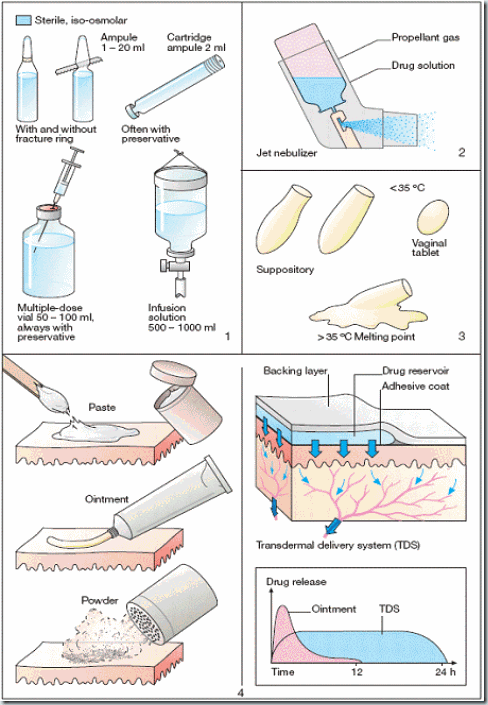
- •Rectal (medicine):
- •Classification:
- •Application location: Gastrointestinal/enteral:
- •Route from application to target:
- •Local or systemic effect:
- •Topical:
- •Enteral:
- •Parenteral:
- •Suppository:
- •Rectal suppositories:
- •Mode of insertion:
- •Vaginal suppositories:
- •Urethral suppositories:
- •Constituents:
- •Indications:
- •Artesunate suppositories:
- •Enema :
- •History:
- •Home usage:
- •Precautions:
- •Dry enema:
- •Nutrient enema:
- •Douche:
- •References:
Route from application to target:
The route or course the active substance takes from application location to the location where it has its target effect is usually rather a matter of pharmacokinetics (concerning the processes of uptake, distribution, and elimination of drugs). Nevertheless, the following routes are commonly referred to as routes of administration:
transdermal (diffusion through the intact skin for systemic rather than topical distribution), e.g. transdermal patches such as fentanyl in pain therapy, nicotine patches for treatment of addiction and nitroglycerine for treatment of angina pectoris.
transmucosal (diffusion through a mucous membrane), e.g. insufflation (snorting) of cocaine, sublingual, i.e. under the tongue, sublabial, i.e. between the lips and gingiva, nitroglycerine, vaginal suppositories
Local or systemic effect:
Routes of administration can also basically be classified whether the effect is local (in topical administration) or systemic (in enteral or parenteral administration):
topical: local effect, substance is applied directly where its action is desired.[9] Sometimes, however, the term topical is defined as applied to a localized area of the body or to the surface of a body part,[10] without necessarily involving target effect of the substance, making the classification rather a variant of the classification based on application location.
enteral: desired effect is systemic (non-local), substance is given via the digestive tract.
parenteral: desired effect is systemic, substance is given by routes other than the digestive tract.
Topical:
epicutaneous (application onto the skin), e.g. allergy testing, typical local anesthesia
inhalational, e.g. asthma medications
enema, e.g. contrast media for imaging of the bowel
eye drops (onto the conjunctiva), e.g. antibiotics for conjunctivitis
ear drops - such as antibiotics and corticosteroids for otitis externa
through mucous membranes in the body
Enteral:
In this classification system, enteral administration is administration that involves any part of the gastrointestinal tract and has systemiceffects:
by mouth (orally), many drugs as tablets, capsules, or drops
by gastric feeding tube, duodenal feeding tube, or gastrostomy, many drugs and enteral nutrition
rectally, various drugs in suppository

Parenteral:
intravenous (into a vein), e.g. many drugs, total parenteral nutrition
intra-arterial (into an artery), e.g. vasodilator drugs in the treatment of vasospasm and thrombolytic drugs for treatment of embolism
intraosseous infusion (into the bone marrow) is, in effect, an indirect intravenous access because the bone marrow drains directly into the venous system. This route is occasionally used for drugs and fluids in emergency medicine and pediatrics when intravenous access is difficult.
intra-muscular
intracerebral (into the brain parenchyma)
intracerebroventricular (into cerebral ventricular system)
subcutaneous (under the skin)
Disadvantages
Typically a more addictive route of administration because it is the fastest, leading to instant gratification. In addition, drugs taken by inhalation do not stay in the bloodstream for as long, causing the user to redose more quickly and intensifying the association between consuming the drug and its effects.
Difficulties in regulating the exact amount of dosage[citation needed]
Patient having difficulties administering a drug via inhaler
Advantages:
Fast: 15–30 seconds for IV, 3–5 minutes for IM and subcutaneous (subcut)
100% bioavailability
suitable for drugs not absorbed by the digestive system or those that are too irritant (anti-cancer)
One injection can be formulated to last days or even months, e.g., Depo-Provera, a birth control shot that works for three months
IV can deliver continuous medication, e.g., morphine for patients in continuous pain, or saline drip for people needing fluids
Disadvantages:
Onset of action is quick, hence more risk of addiction when it comes to injecting drugs of abuse
Patients are not typically able to self-administer
Belonephobia, the fear of needles and injection.
If needles are shared, there is risk of HIV and other infectious diseases
It is the most dangerous route of administration because it bypasses most of the body's natural defenses, exposing the user to health problems such as hepatitis, abscesses, infections, and undissolved particles or additives/contaminants
If not done properly, potentially fatal air boluses (bubbles) can occur.
Need for strict asepsis
Uses:
Some routes can be used for topical as well as systemic purposes, depending on the circumstances. For example, inhalation of asthma drugs is targeted at the airways (topical effect), whereas inhalation of volatile anesthetics is targeted at the brain (systemic effect).
On the other hand, identical drugs can produce different results depending on the route of administration. For example, some drugs are not significantly absorbed into the bloodstream from the gastrointestinal tract and their action after enteral administration is therefore different from that after parenteral administration. This can be illustrated by the action of naloxone (Narcan), an antagonist of opiates such as morphine. Naloxone counteracts opiate action in the central nervous system when given intravenously and is therefore used in the treatment of opiate overdose. The same drug, when swallowed, acts exclusively on the bowels; it is here used to treat constipation under opiate pain therapy and does not affect the pain-reducing effect of the opiate.
Enteral routes are generally the most convenient for the patient, as no punctures or sterile procedures are necessary. Enteral medications are therefore often preferred in the treatment of chronic disease. However, some drugs can not be used enterally because their absorption in the digestive tract is low or unpredictable. Transdermal administration is a comfortable alternative; there are, however, only a few drug preparations that are suitable for transdermal administration.
In acute situations, in emergency medicine and intensive care medicine, drugs are most often given intravenously. This is the most reliable route, as in acutely ill patients the absorption of substances from the tissues and from the digestive tract can often be unpredictable due to altered blood flow or bowel motility.
